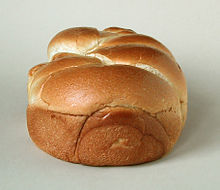brioche
The brioche [ bʀijɔʃ ], sometimes referred to as “apostle cake ” in German, is a fine table pastry made from yeast dough that is rich in egg and fat and consists of two or three dough balls of different sizes placed one on top of the other like a pyramid. In Austria , brioche is a white pastry of different sizes and shapes that is coated with egg and sprinkled with sugar . The consistency and taste of the dough are similar to those of Buchteln .
The pastry originally comes from France . The brioche is characterized by the mostly fluted collar and the smooth, round dough head on top. This Parisian shape has only been typical since the 19th century. There are also filled brioches in France. The Brioche Vendéenne from the Département Vendée , which is flavored with rum , brandy or orange blossom, is also known, along with other regional variants . It used to be a special variant for Easter .
history
The word brioche has been used in France since the 15th century. It is probably derived from brier , a Norman dialect form of broyer , which means something like 'crush' or 'pound', but can also stand for rolling out the dough with a rolling pin . A less likely attribution of the word to the cheese brie comes from Alexandre Dumas the Elder . According to him, this cheese was once processed in the brioche.
The likely place of origin is Normandy , known since the Middle Ages for the quality of its butter, an essential ingredient in brioche. Brioches have only been recorded in Paris since the 17th century . The oldest preserved recipe appeared in 1742.
anecdote
According to a widespread anecdote, Marie Antoinette (1755–1793) is said to have replied, after being told that the poor of the population had no bread to eat: “ S'ils n'ont plus de pain, qu'ils mangent de la brioche »(German:“ If you have no more bread , you should eat brioches ”). This sentence can be proven for the first time in the autobiographical Confessions of Jean-Jacques Rousseau , where it is put in the mouth of an unnamed "great princess":
"Enfin je me rappelai le pis-aller d'une grande princesse à qui l'on disait que les paysans n'avaient pas de pain, et qui répondit: Qu'ils mangent de la brioche. »
“At last I remembered the information tool from a great princess who was told that the peasants had no bread, and she replied:“ You can eat cake. ”"
The context is that Rousseau had stolen wine and wanted something to eat with it, but found himself too well dressed to buy simple bread. Whether or not Rousseau is reproducing an actual utterance by a noblewoman - he certainly cannot have meant Marie Antoinette, because even if the Confessions were only published posthumously from 1782, he had already written the first six books between 1765 and 1767, when Marie Antoinette was still was a child and lived in Vienna. In addition, the 11th chapter in question is supposed to deal with events that took place before 1741. The frequent translation of brioche as 'cake' in this quote is misleading, as the French brioches in the 18th century contained little butter and sugar and were closer to white bread than cake.
Switzerland
In Switzerland, the name is sometimes used for an aperitif biscuits that consist of a baked light-colored bread (20 to 30 cm high, round base with a diameter of approx. 20 cm) that is cut into several horizontal layers and then, for example, with salmon, Spread pie, ham being filled. In terms of taste, it is roughly equivalent to a sandwich, not toasted , but a bit like butter and a little sweeter with a slightly smoother consistency.
Italy
In northern Italy , brioche is the name for a croissant (Italian: cornetto ). In Sicilian cuisine , the brioscia is usually served as an accompaniment to granita or sliced and filled with ice cream .
Web links
Individual evidence
- ↑ "From an encyclopedia of culinary art from 1886". Quoted from festagsrezepte.de . Retrieved January 14, 2018.
- ^ IREKS Arkady Institute for Bakery Science (ed.): IREKS ABC of the bakery . 4th edition. Institute for Bakery Science, Kulmbach 1985
- ↑ a b c Brioche . In: Alan Davidson: The Oxford Companion to Food . 2nd. ed. Oxford 2006, p. 106 f.
- ↑ Brioche . In: etymonline.com . Retrieved January 14, 2018.
- ↑ Alexandre Dumas: Grand dictionnaire de cuisine . Alphonse Lemerre publishing house, Paris 1873. p. 304 (French; digitized version ).
- ^ Jean-Jacques Rousseau: The Confessions. First part. From the French by Hermann Denhardt. Philipp Reclam jun., Leipzig 1882, chapter 11. Online version: Jean-Jacques Rousseau: The Confessions in the Gutenberg-DE project
- ↑ Eisburger: Curious trends from Sicily. In: Duo - Sicilian Ice cream. Retrieved December 13, 2019 .


